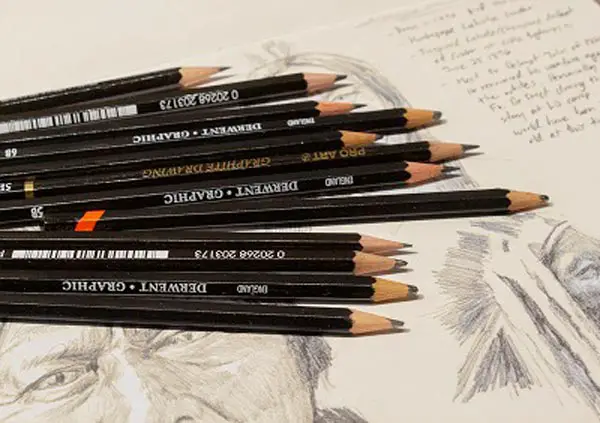
The Lightest and Darkest Drawing Pencils-And How To Use Them
Using the right drawing pencil can make a big difference in how your sketches or drawings turn out. We will talk about the different grades of drawing pencils and how to best use them.
For graphite drawing pencils on the market, the lightest is 6H, while the darkest available is 8B. The higher the number in each grade, the lighter or darker it is. So a 6H will be lighter and harder than a 2H, and a 8B will be much darker and softer than a 2B. F and HB are middle-grade pencils.
Below we go into further detail on each group and how to best use them.
The Range of Drawing Pencils and What They Look Like
| 6H | 5H | 4H | 3H | 2H | H | F | HB |
| B | 2B | 3B | 4B | 5B | 6B | 7B | 8B |
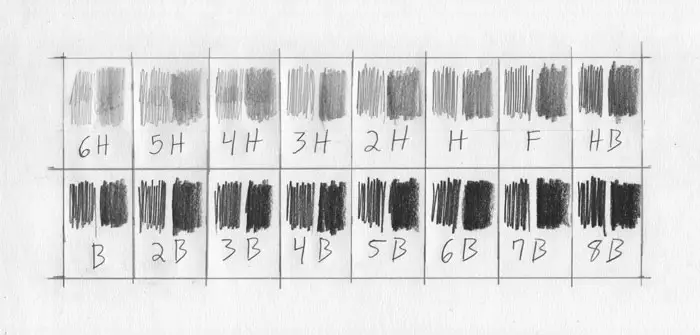
As you can see above, a 6H is a very light pencil and 8B is very dark.
H-Grade Pencils and How To Use Them
H-grade pencils generally have two uses. The first is for lightly sketching in outlines and working out your proportions or composition before getting into the serious part of the drawing. The second is if you want to limit the value range of your drawing to a higher (lighter) key.
H-grade pencils sharpen very nicely to an extremely fine point and retain that point for longer periods of time. They require less sharpening, which makes them great for detailed work that doesn't require dark values, but they have a slightly abrasive feel due to their higher clay content and work best on smooth paper with little texture. You can use the side of the graphite tip for subtle and high-value (light) shading techniques.
If used with a light hand, H-grade pencil strokes will erase very easily. However, their hardness can easily cause indentations in your paper. This can not only make them difficult to erase but also leaves behind an indentation in your paper even if you are able to remove all the graphite. This may not be all bad if you want to have a more permanent outline that you can shade over, but be certain about those outlines before you press down. And remember, pressing down will dent and possibly even tear the paper.
Another nice thing about H-grade pencils, especially the higher numbers like 3H and above is that they smear or smudge very little. This can be very handy for traveling sketchbooks and keeping your hands clean while drawing. However, the light lines they create may be difficult to see when sketching in bright sunlight or dark areas, and blending is more difficult.
See the types of pencils, charcoal, and paper I use on the Drawing and Sketching Resources Page.

F and HB-Grade Pencils
F and HB pencils are middle of the road and more general use pencils. F tends to still be a tad hard, while HB and B tend to be a nice blend of both worlds. Though they cannot get very dark.
B-Grade Pencils and How to Use Them
While they can also be used for outlines, B-grade pencils are generally used for shading and tonal work. The high-numbered grades have a smooth, velvety feel on the paper and they can make darker gray tones which can border on black. For those who like to work less with outlines and more with tones, B pencils are the optimal choice as their softness will cover the paper more quickly with darker solid tones than will an H-grade pencil.
B-grade pencils work well on both smooth paper and paper with a slight bit of texture Their soft consistency will not cause the same paper indentations that you get with an H-grade. Strokes applied with little pressure tend to erase easily, but strokes applied with a lot of pressure are very difficult if not impossible to erase.
While B-grade pencils are easy to sharpen, they cannot achieve the same razor-sharp point that you get with an H-grade. Even if you sharpen it to a fine point, that point will almost immediately disappear when you start to use it as the soft graphite wears down quickly. As a result, B-grade pencils require more frequent sharpening.
B-grade pencils are very easy to blend. While this makes them more attractive for tonal work it also makes them messier. If you are going to use them in a carry-along sketchbook, I recommend a hardbound sketchbook as the pages will not rub together as much as a spiral-bound book. But even with a hardbound sketchbook, you will still end up with some smudged sketches. Use a fixative if you really want to preserve your sketches.
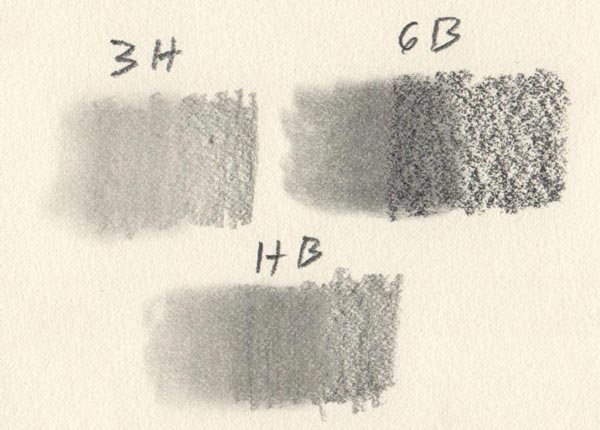
Eliminating the Glare in Your Pencil Drawings
One drawback (no pun intended) that can be more apparent with darker B-grade pencils (though it can happen with any grade) is that they can leave a glare or shine which reflects light in a very annoying manner. When you apply the pencil with a very heavy hand or overwork the area, you are actually burnishing the graphite, a similar effect to polishing metal, which gives it a very smooth and shiny effect.
Once this happens, it's very difficult to undo. A matte fixative spray can help eliminate some of the glare, but to avoid this in the first place, make sure you don't overwork the area or apply too much pressure. Using a dark enough pencil in the first place is the best solution. Also, keep in mind that a heavily-textured paper will result in little white areas that are difficult to darken without applying a lot of pressure. The smoother the paper, the easier it is to darken.
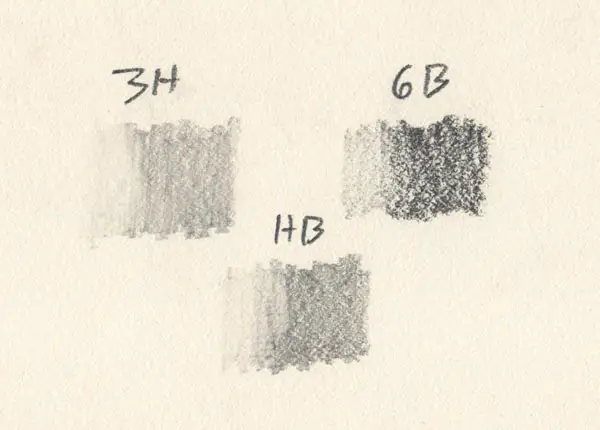
Getting Even Darker Drawings
A more recent development has been that of carbon pencils. Instead of using the allotrope of carbon, which is graphite, carbon itself is used which can achieve even darker results than graphite. It also doesn't have that annoying glare that you can get with graphite when heavily applied. Some manufacturers are combining graphite with carbon to achieve even darker-grade pencils all the way up to 14B.
Another way to go is charcoal. This medium, especially compressed charcoal, can get very black and it can be re-worked and layered without any glare. However, charcoal is very messy and is only convenient for a traveling sketchbook if you are able to spray your sketches with fixative as soon as they are completed.

Which Sketching Pencil Should You Use?
It depends on your style and objectives. If you are doing gesture-type sketches or contour-type drawings where outlines are most important, then an HB or lighter is the way you want to go. You will be able to maintain a nice sharp point for a longer period of time, and the outlines won't be easily smudged away.
If your objective is to capture the effect of light and form, then B or darker would work best. You can use the side of the exposed graphite to quickly cover large areas with wide dark strokes and easily blend those strokes for a smooth transition.
Do I Need to Buy Every Pencil Grade?
No, buying every pencil grade from 9H-9B is not at all necessary. If you are starting out and unsure, you may want to buy an entire set and see what works best for you. Most likely you will find that a few grades will constantly need to be replaced, while others will hardly ever get used. If you are on a budget, I recommend starting with an HB, 4H, and 4B and go from there.
When traveling and quickly sketching on the spot, I tend to default to an HB or B since they can handle almost any scenario in a sufficient manner and they don't get too messy. My primary tool of choice when sketching is a technical pencil with HB graphite. This is very convenient as it doesn't require a pencil sharpener. I'll also bring along a regular B or 2B pencil if I want to do some quick shading.
As with anything, you should really experiment and see what works best for you.
I hope that helps. Please be sure to subscribe and leave your comments below.
Keep Sketching!
Jason Tako is a nationally known fine artist who specializes in western, wildlife, plein air, and Historical Native American subject matter. He spent his learning years sketching the wetlands and wooded areas of rural Minnesota. He has been featured in Plein Air Magazine and Western Art Collector Magazine and he was the Featured Artist for the 2020 Southeastern Wildlife Expo. See his work at www.JasonTako.com and his demonstrations on his YouTube Channel.
Warning: Undefined array key "preview" in /home3/mysketc2/public_html/wp-content/plugins/oxygen/component-framework/components/classes/comment-form.class.php on line 75
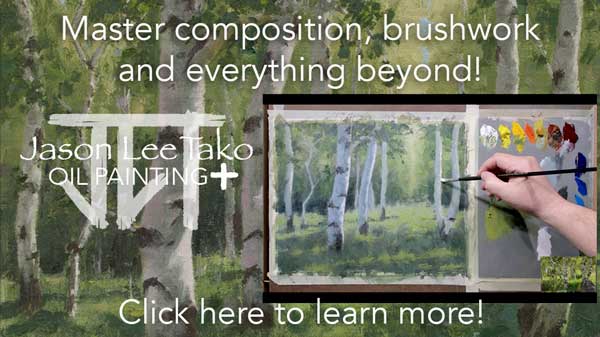

Warning: Undefined array key "preview" in /home3/mysketc2/public_html/wp-content/plugins/oxygen/component-framework/components/classes/comment-form.class.php on line 79